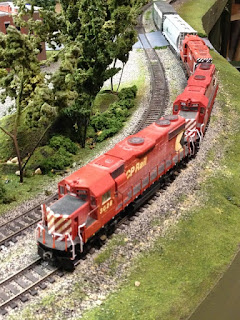When Bob Fallowfield was a kid, he enjoyed
nothing better than going down the CP Rail tracks in his hometown of Woodstock,
Ont. to watch trains.
Bob isn’t a kid anymore (he’s 39), and he
doesn’t live in Woodstock. But he can still relive those memories through his Great
Canadian Model Railroad—the CP Rail Galt Sub.
On Bob’s layout, it is always October,
1980. He chose that date not only because of childhood memories, but also
because that was a good time for CP Rail.
Traffic was high, and there was a mix of
newer and older power—leased units from the U.S., different paint schemes and wooden
and modern vans.
The
Layout
Located in a 12 x 30 foot basement room,
the layout is centred on the city of Woodstock and the CP Rail Galt Sub. line
that runs between Toronto and the U.S. border at Windsor.
It also includes branchlines to St. Marys,
St. Thomas and Tillsonburg/Port Burwell (represented by staging).
All track on the layout is handlaid,
including the switches (using jigs from FasTracks). Mainline track is code 83;
the rest is code 70 and 55.
Train lengths are 15-20 cars, and the
locomotives a mix of Bowser, Kato, Overland, Atlas, and Proto.
Bob uses DCC from Digitrax to control the
trains. The scenery base is extruded foam and plywood. Static grass and ground
foam are used for ground cover. The structures are all sratchbuilt or
kitbashed.
Signature structures on the layout include
the Canada Cement LaFarge plant at Zorra and Highway 59 over the tracks and the
Thames River at Woodstock.
The bridge is a special place for Bob.
“As a kid I took many trips to my dad's
shop on evenings and weekends, which meant two trips over that bridge,” he
says.
“Given my love of trains, Dad would often
detour through the yard so I could take it all in.”
Operations
The idea behind the layout for Bob is to
replicate the railfan experience. All photos of his layout are taken as if they
were taken trackside. No drone shots allowed!
To operate the layout, Bob uses prototype
CP Rail forms from 1980 to govern train movements and switching. Four operators
can be kept busy during a session.
Operations are fed by two ten-track
staging yards for east and westbound traffic beneath the layout.
There are also four staging tracks
representing St. Marys, St. Thomas and Tillsonburg/Port Burwell, although part
of the St. Thomas Sub. is modelled behind the backdrop along one side of the
layout.
Trains begin their journeys in staging,
climb to appear on the layout itself, and then disappear into staging again
after travelling once around the room.
Many trains roar right on
through Woodstock, but some stop to drop off cars for nearby Zorra and the
branchlines to St. Thomas, St. Marys and Tillsonburg/Port Burwell. There is
also switching to be done in Woodstock itself.
No
Longer a Lone Wolf
What’s truly amazing,
considering the quality and completion of the layout, is that Bob did it all by
himself—in just five years.
For inspiration and
information, he relied on magazines, websites and how-to books.
“I’m a sponger for
information and enjoy research,” he says. “I'm also not afraid to dive in and
botch it up and try again.”
“Sharing photos of
the layout is a way I can give back the hobby,” he says. “I’ve been a taker for
a long time. Now it’s time to give something back. I really want to be a
contributor . . . . I am more than willing to share my techniques, successes
and failures.”
The
Future
As for the future, Bob has more details to
add, and he wants to finish the backdrop. That, and enjoy operating the layout,
either alone or with friends.
That, and take more photos to share with
others.
“I’m like a chef. I don’t want any other cooks in my kitchen,” he says of his modelling philosophy. “But once the food is ready, I am happy to share it with anyone.”












































